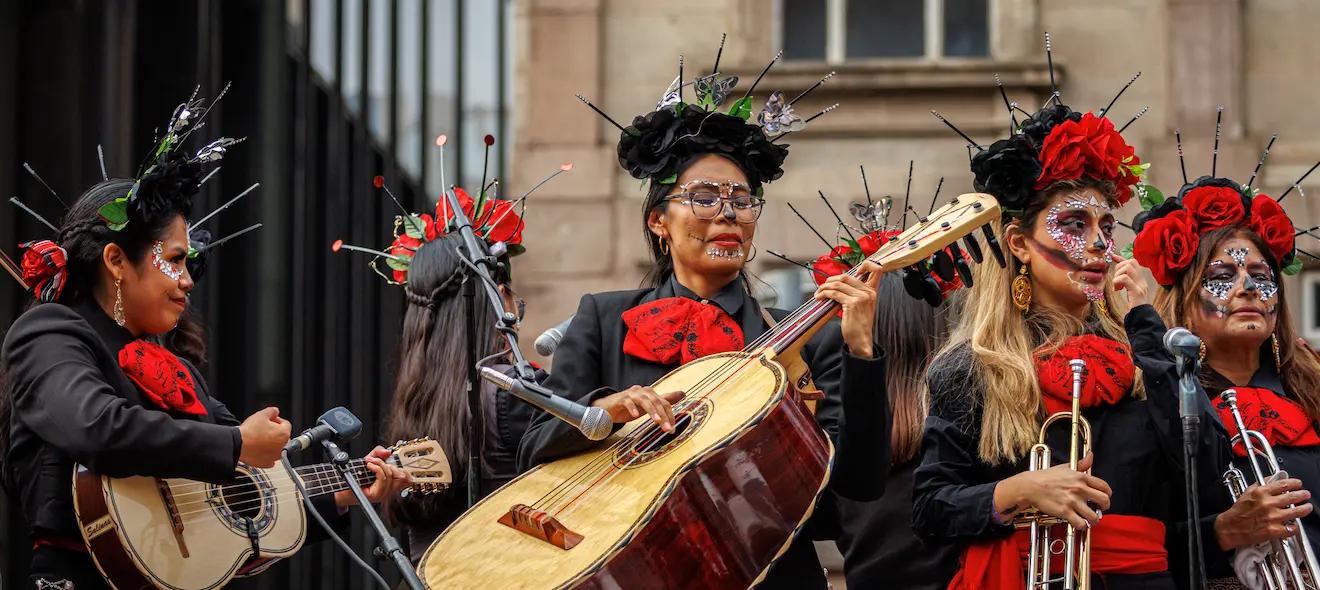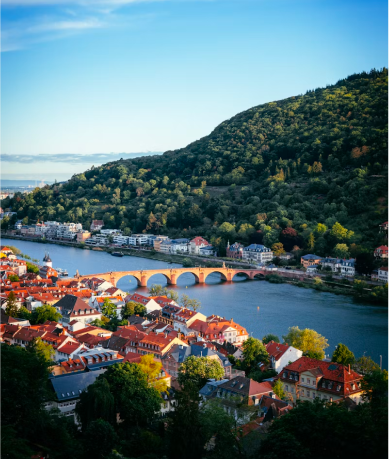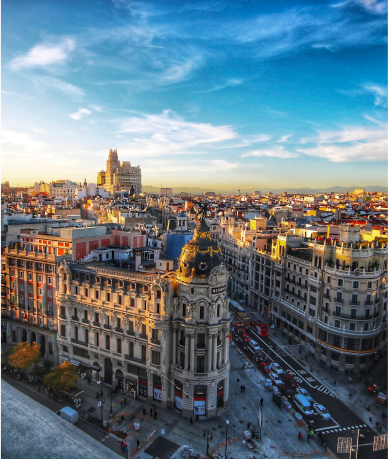Across cultures, people have always found ways to honor those who came before them. In Europe, families light candles to remember their loved ones on All Saints’ Day. In Japan, lanterns drift gently across rivers during Obon, guiding memories and spirits. In Mexican culture, remembrance comes alive in bright marigolds, flickering candlelight, and the smells and flavors of food carefully prepared for those who have passed. This is Día de los Muertos, or Day of the Dead. Celebrated every year on November 1 and 2, it is far from a somber occasion. Instead, it is a lively, heartfelt ritual full of memories, music, and joy, where families come together to share stories, build altars, and show that love and connection never truly fade.
At Schiller International University, these traditions serve as cultural points of reflection and as windows into humanity’s shared language. Day of the Dead 2025 gives students a chance to see how cultural practices connect generations, spark empathy, and make learning about the world deeply personal and meaningful.
Origins of the Day of the Dead
The history of the Day of the Dead dates back hundreds of years. Its roots lie in the traditions of pre-Hispanic civilizations, including the Aztecs, Maya, and Purepecha. For these communities, death was not seen as an ending, but as a natural part of life’s ongoing cycle. People created rituals and offered food, flowers, and meaningful objects to honor their ancestors and stay connected with the spirit world.
When Spanish colonizers arrived in the 16th century, Catholic traditions, such as the All Saints’ Day and All Souls’ Day, blended with these indigenous practices. This merging gave birth to the Día de los Muertos we celebrate today, a festival where honoring those who have passed is inseparable from celebrating life itself.
At its heart, the Day of the Dead is about memory, gratitude, and community. It reminds us that the past shapes our present and that honoring our ancestors deepens our understanding of ourselves and the world around us.
Key Traditions and Symbols

A notable characteristic of Día de los Muertos traditions is the way they bring people together through meaningful symbols and shared activities. The following are some of the most important elements:
- Altars (ofrendas): At the heart of the celebration, altars are decorated with photographs, candles, bright marigolds (cempasúchil), and food and drinks that the departed loved ones once enjoyed. Every item tells a story and creates a tangible connection between the living and those who have passed.
- Sugar skulls (calaveras): These colorful, intricately decorated treats are playful and profound. They honor the cycle of life, reminding us that death is a part of life and that joy and remembrance can coexist.
- Food and music: From pan de muerto to regional dishes, meals bring families together, while music fills the air with celebration and memory, creating moments of shared joy and reflection.
- Community gatherings: The Day of the Dead is as much about people as it is about rituals. Family, friends, and neighbors come together, reinforcing bonds and showing that even after someone passes away, their memory lives on in the hearts of those left behind.
Through these symbols and experiences, you can feel ancestral traditions come alive. They offer a window into how culture expresses identity, values, and emotion, and invite you to reflect on the ways memory and celebration shape who we are.
Cultural Lessons from Día de los Muertos
Being part of or simply observing Day of the Dead celebrations provides a glimpse into tradition. It provides meaningful lessons that stay with you long after the festival ends.
- Respect for history and ancestry: Every altar, every candle, every ritual is a reminder of where we come from. They teach us to honor the paths and lives that have shaped the present.
- Empathy and shared humanity: Seeing how families remember and celebrate their loved ones helps us connect with the emotions of others. It encourages understanding, compassion, and a deeper awareness of human experience.
- Cultural literacy: Engaging with these traditions sparks curiosity and reflection. It shows the richness of human expression and the many ways people celebrate life, memory, and connection across the world.
For international students, these lessons go far beyond the classroom. They become part of a larger journey toward global citizenship, helping you develop empathy, cultural awareness, and reflective skills essential in a multicultural world.
Global Learning Through Local Traditions
The Day of the Dead is not just a celebration rooted in Mexican culture. It is part of a broader human experience that transcends borders. Around the world, communities have developed their own ways of remembering and honoring those who came before them.
- In Europe, families light candles and visit cemeteries on All Saints’ Day, celebrating the lives of loved ones and keeping their memories alive.
- In China, the Qingming Festival invites families to clean ancestral graves, offer food, and reflect on the legacy of those who came before.
- In Japan, Obon sees lanterns floating across rivers, guiding spirits back home and reminding the living of their enduring connections.
Exploring these parallels reveals that honoring ancestors is a universal human practice, expressed through rituals, food, music, and community gatherings. For students, this is an invitation to see the threads that connect diverse societies and human experiences.
Schiller International University’s Approach
Schiller’s commitment to cultural immersion and international education ensures that our students have opportunities to actively engage with global traditions like Día de los Muertos. Through our multi-campus models in Spain, France, Germany, and the USA, you will be exposed to a wide range of cultural practices. You will develop intercultural competence, become empathic, and master a global citizen mindset through these experiences.
Practical Takeaways for Students
Experiencing festivals such as the Day of the Dead 2025 offers tangible benefits for international students:
- Enhanced study abroad experience: Connecting classroom learning with local culture creates memorable, transformative experiences.
- Intercultural skills: Engaging with traditions develops empathy, communication, and adaptability.
- Personal reflection: Observing and participating in cultural rituals encourages students to reflect on life, memory, and human connection.
Even small interactions such as lighting a candle, helping create an ofrenda (an altar decorated with offerings for the deceased), or listening to family stories can leave a lasting impact on one’s personal and academic growth.
The Day of the Dead teaches that life and memory are inseparable, and that cultural traditions are powerful tools for understanding humanity. At culturally diverse Schiller International University, you will learn how to connect history, culture, and education.
Discover Schiller’s multi-campus opportunities and immerse yourself in cultural experiences that shape the global citizens of tomorrow.
FAQs
Q1. What is the Day of the Dead, and why is it celebrated?
Answer: The Day of the Dead, or Día de los Muertos, is a festival celebrated on November 1 and 2 that honors deceased loved ones through rituals, altars, and offerings. It celebrates life, memory, and community.
Q2. How does the Day of the Dead connect to Mexican history and culture?
Answer: The festival's roots lie in pre-Hispanic traditions and Catholic observances. It blends indigenous practices with All Saints’ Day and All Souls’ Day, reflecting Mexican culture’s respect for ancestors and the cycle of life.
Q3. What symbols and traditions are central to Día de los Muertos?
Answer: Key elements of the Day of the Dead include altars (ofrendas), sugar skulls (calaveras), marigolds (cempasúchil), favorite foods of the deceased, music, and community gatherings.
Q4. How can international students learn from festivals like the Day of the Dead?
Answer: Through participation and observation, students can gain cultural literacy, empathy, and a deeper understanding of history, ancestry, and global perspectives.
Q5. How does Schiller International University promote global cultural understanding?
Answer: Through multi-campus programs, cultural immersion, and classroom reflection, Schiller integrates global traditions into education, fostering empathy, multicultural learning, and global citizenship.

 Request information
Request information









